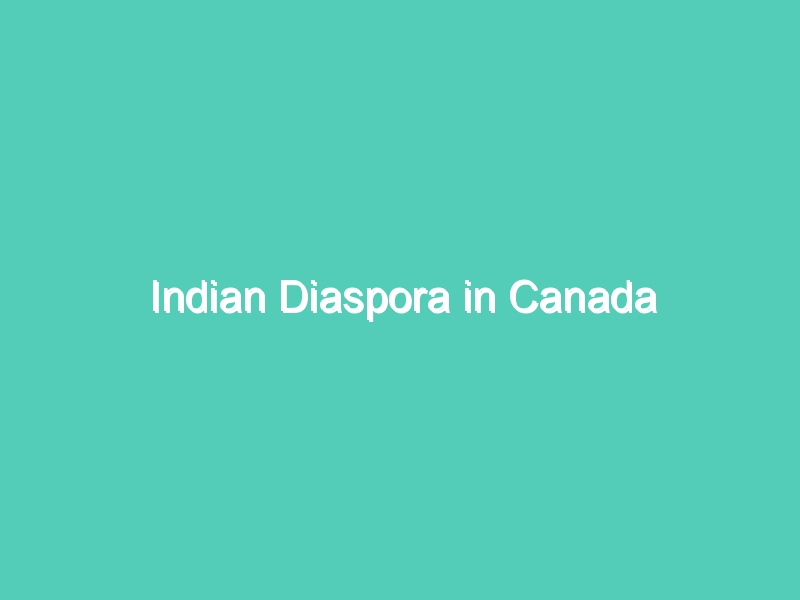The Indian Diaspora in Canada The early Indo-Canadian community was mostly composed of young Sikh men from Punjab, who came to British Columbia with the hope of finding the better economic opportunities (Johnston, 1984; Sampat-Mehta, 1984; Walton-Roberts, 2003; Bhat & Sahoo, 2003). Canada became first known to East Indians in 1897. Stopping in Canada route in their journey home from Britain to India, a Sikh regiment of the British Indian Army participated in a parade to celebrate Queen Victoria’s Goldon Jubilee in London. This regiment visited British Columbia (Tatla, 1999; Kurian, 1993) and subsequently recommended North America to the other Sikhs who were seeking employment opportunities abroad. At the beginning, India, like Canada, was a British colony; Indians did not need visa to travel to Canada. With increasing the number of immigrants, white Canadians felt that “the growing number of Indians would take over their jobs in factories, mills and lumberyards. Hence, anti-Asian riots started against the Chinese and Japanese, and soon included Indians in the unwanted Asian ethnic groups. Fear of labor competition was followed by racial antagonism and demand for exclusionary laws. In British Columbia, attempts were made to pass stringent laws discouraging the immigration of Indians to Canada (Sibia, 2007). In 1947, Indians were allowed to vote “after an intense struggle for elementary political and property rights” (Sheel, 339). Singhvi in his report writes: Nothing demonstrated how the destinies of the Diaspora and India were bound together, as the fact that Indo-Canadians won the right to vote soon after the same time India won its Independence from colonial rule. Thus Indian Independence awakened the pride of the Indo-Canadian community, which gave an unprecedented welcome to the first Indian High Commissioner Shri H.S. Malik. Nehru strongly advocated its cause during his visit to Canada. (Singhvi, 2001) Although the Canadian immigration policy became more liberal at this time allowing Indian citizens to vote and to study in the universities and collages (Jayaram, 25-47), the major changes in immigration policy occurred in 1962. With the reformulation of immigration policy and the removal of discriminatory laws based on race and nationality in 1967, Indian immigrants “were assessed on a point system relating to education and training, occupational skill, and employment opportunities or arrangements. The new point system was closely related to the needs of the Canadian economy and placed a premium upon professional and technical skills” (Tinker, 192). As a result, a new group of East Indians came to Canada who was more educated by 1991; the East Indo-Canadian community became one of the most significant proportions of the total immigrant populations in Canada. The current state of the Indian Diaspora in Canada In 1967, with the replacement of a point system for immigration quotas based on ethnicity, Indian immigrant population began to increase. According to Statistics Canada, since the late 1990’s, approximately 25,000-30,000 (Salehi, 2007) Indians arrive each year, making East-Indians the second highest group immigrating to Canada after Chinese immigrants. The majority of the Indo-Canadian population is comprised of new immigrants from India, or second and third generation East-Indian Canadians. Half of the East Indian population in Canada is Punjabi. The other Indian ethnic communities are Gujaratis, Tamils (Indian as opposed to Sri Lankan), Keralites, Bengalis, Sindhis and others. Due to such cultural and ethnic diversity, East Indo-Canadians speak various languages. The most widely spoken language is Punjabi. The second broadly spoken language is Tamil. Urdu is mostly the language of Muslims who come from North India. Hindi is mainly spoken by Indo-Canadians from North India. Gujarati is also spoken by people from Gujarat. Bengali is the language of people from the state of West Bengal. East Indo-Canadians are very diverse in terms of religious backgrounds. Sikhs, at 33.5% are the largest group among Indo-Canadians, while this group comprises only 2% of the population in India. In India, Hindus, at 80%, are the greater population. However, they comprise only 27% of the Indo-Canadian population. Muslims and Christians respectively are 17.5% and 16.5% (Salehi, 2007) of East-Indian population in Canada.
Research paper – Towards Excellence: An Indexed, Refereed & Peer Reviewed Journal of Higher Education / Mr. Mihir H Trivedi



